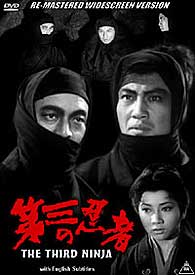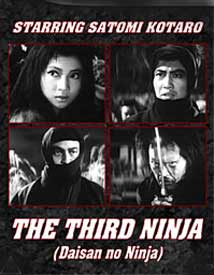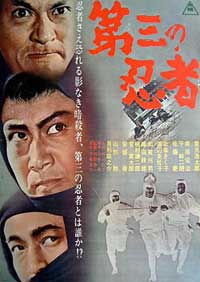 Kai Provence, 1572, the Warring States period, Takeda Shingen wants Oda Nobunaga's head. Nobunaga's Iga spies want the head of Takeda's most notorious spy, Chidoken. Any captured ninjas hired by Takeda are executed in maximumly horrific ways by Nobunaga. Kai Provence, 1572, the Warring States period, Takeda Shingen wants Oda Nobunaga's head. Nobunaga's Iga spies want the head of Takeda's most notorious spy, Chidoken. Any captured ninjas hired by Takeda are executed in maximumly horrific ways by Nobunaga.
Among Iga spies after Chidoken, Ueno-no-Tone (Kotaro Satomi) is in a competition with Kiheiji (Kei Sato) for Chidoken's head. A third figure, the ninja living as a mendicant priest Yonkanme (Koji Nanbara), has a personal grudge with Chidoken, so joins Kiheiji & Tone in the hunt.
Such is the central premise of the widescreen black & white The Third Ninja (Daisan no ninja, Toei, 1964), a gloomy film noir that treats ninja techniques seriously. A plaintive soundtrack incorporates a harmonica, not exactly a traditional instrument but it helps sustain a mood of darkness & sorrow.
Most Toei Studios ninja films are not this harsh, but are frequently aimed at a teen audience with teen-appeal antics. But this one, & a handful of others such as Seventeen Ninjas (Jushichinin no ninja, 1963), aim to cash in on the popularity of the all-out-gloomy ninja films from Daiei Studios, namely the Shinobi-no-mono series which began in 1962. Kotaro Satomi is not the equal of Raizo Ichikawa in such a dark role, but he's pretty good even so.
The grimness of the tale is most strikingly reflected in the character of Mori-no-Yohei. He had once been a top ninja, but lost an arm, his tongue, & got his face hideously scared, all for adhering to the ninja rule of silence under torture. He's now maltreated as an aging servant pitied or despised for his extreme ugliness, for where ninja heroics are concerned, there are never rewards.
Chidoken lives underneath Takeda Shingen's crapper. He has used this filithy meeting place in order to communicate with his master, amidst Takeda's feces, for twenty years, coming & going by an underground cavern of sewage.
 His primary assignment is to kill Oda Nobunaga, which is why Nobunaga has sent Kiheiji & Tone to compete against one another for the life of Chidoken. His primary assignment is to kill Oda Nobunaga, which is why Nobunaga has sent Kiheiji & Tone to compete against one another for the life of Chidoken.
They suspect that Chidoken is actually Horibe Sanzaemon, but Sanzemon turns out to be dead. An old priest remembers burying him in an anonymous Ninja graveyard. The mystery "Who then is Chidoken really?" will eventually lead full circle to that old priest, who faked the grave.
Sagume (Misako Watanabe) was the orphaned daugther of Sanzaemon. Her quest to find her father ended at an anonymous grave. She returns home in sadness, to her vile uncle Gendaiyu (Isao Yamagata) who has served as her foster father.
Gendaiyu becomes a further menace to Sagume when he discovers she's in love with the ninja Ueno-no-Tone. Although Tono loves her, too, romantic feelings are prohibited of ninja, & he can do little to assist her.
Sagume's sister Chigusa (Kikuko Hojo) is murdered trying to intervene in Sagume's behalf. Sagume runs away to find Tone. The household servant Yohei, disfigured one-armed monster though he is, will avenge the death of Chigusa, whom he secretly loved.
On an auspicious night for killing Nobunaga, the three ninjas after Chidoken prepare to attack him when he's most apt to be near his intended target.
Kiheji comes to a gruesome end when Chidoken finally reveals himself. The final conflict begins with a shuriken fight, then duels with the intermediate-length ninja swords, use of numerous ninja techniques in darkness, rope action, & one really great surprise.
Chidoken like a creature of darkness is extremely hard to kill & dies slowly even when horrifically injured. He lives long enough to be faced by his daughter Sagume, so that his monstrous personality melts away into shame & sadness.
|

